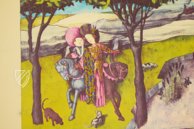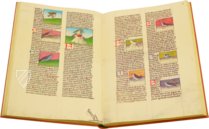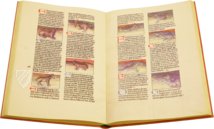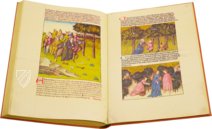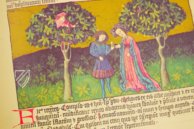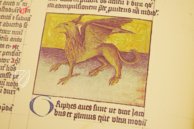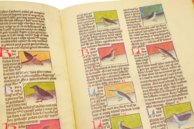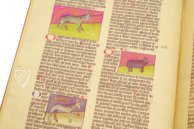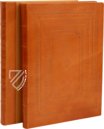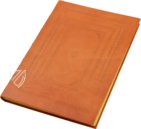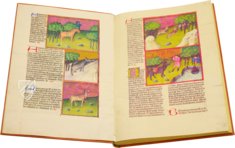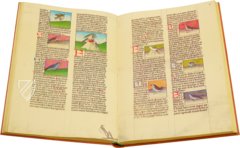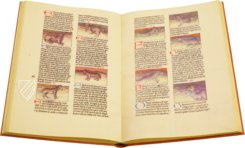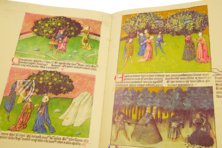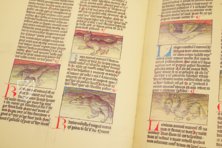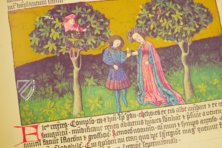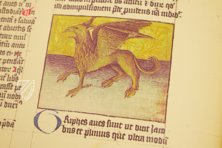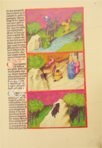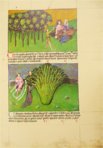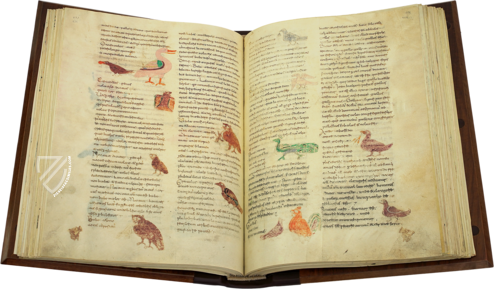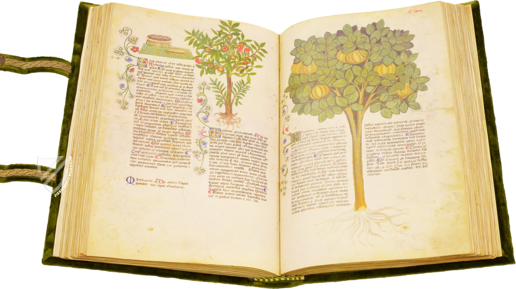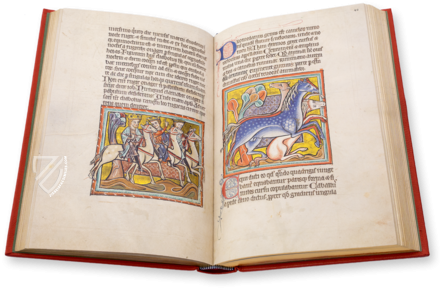Liber de natura rerum - Codex C-67
(1,000€ - 3,000€)
Thomas of Cantimpré was a leading philosopher and theologian in 13th century Europe and the author of numerous works on various subjects but is most famous for writing Liber de natura rerum. It is a comprehensive encyclopedia that enjoyed great popularity during the Late Middle Ages and has been reproduced in many manuscripts. The work draws on numerous sources both pagan and Christian, ancient and contemporary, and divides knowledge about the natural world into twenty chapters. This manuscript originated ca. 1440 and is adorned by 611 miniatures by Martinus Opifex, who was active at the court of Holy Roman Emperor Frederick III. Aside from the text by Thomas of Cantimpré, it also contains the medical treatise Tacuinum Sanitatis by Ibn Buṭlān.
Liber de natura rerum - Codex C-67
The encyclopedic text Liber de natura rerum is the most significant work by Thomas of Cantimpré (1201–72), who dedicated almost twenty years of his life to writing it between 1225 and 1244. This genre of literature was popular during the Late Middle Ages and the work presents itself as a complete and exhaustive compendium of the previous scientific history, which is intended for use by clergymen. The work draws on various ancient and medieval sources, and
A Life of Contemplation and Edification
Thomas of Cantimpré was a medieval writer, preacher, theologian and Dominican friar from Flanders. Born into a noble family, his father fought alongside Richard the Lionheart (1157–99) in Palestine during the Third Crusade before fathering his son, whom he sent to Liege in 1206 for education at the age of five. In 1217, Thomas entered the Canons Regular of St. Augustine in the Abbey of Cantimpré near Cambrai, where he attained the priesthood and spent the next 15 years of his life. After entering the Domincan Order in Leuven in 1232, he was sent by the Order to Cologne the following year. There he studied theology under Albertus Magnus (ca. 1200–80). After four years in Cologne, he briefly went to Paris before returning to Leuven, where he rose to Magister of philosophy and theology before becoming a sub-prior and lector in 1246. He then seems to have grown tired of academic life and spent most of the last period of his life preaching in Brabant, Germany, Belgium, and France. Thomas was honored with the title of “General Preacher” in recognition of his contributions.
A Medieval Encyclopedia
The text is divided into twenty chapters covering topics such as the human body and soul (separate chapters) various animals, plants, stones, metals, and finishes by discussing cosmography and the four elements. Thomas of Cantimpré’s primary source was the ancient Greek philosopher Aristotle, who was regarded as authoritative in medieval Europe, but also drew heavily from Pliny the Elder and Gaius Julius Solinus. Other sources include St. Ambrose and contemporaries like Jacques de Vitry and William of Conches, as well as numerous others that are either unnamed or difficult to recognize. Liber de natura rerumenjoyed great popularity as evidenced by the many manuscripts of it that have survived to the present and was often plagiarized during the Renaissance for catalogs of animals, stones, and monsters.
Miniatures from an Imperial Court Painter
The manuscript, which is now stored in the Biblioteca Universitaria de Granada, is generously adorned with 611 magnificent miniatures by Martinus Opifex (ca. 1400–56), who was active at the court of Holy Roman Emperor Frederick III (1415–93). It also features the famous medical treatise Tacuinum Sanitatis by Ibn Buṭlān (1001–64), making this one of the most comprehensive manuscripts of the work. This is a true synthesis of the arts combining the “current” state of knowledge with some of the finest illumination of the period.
Codicology
- Alternative Titles
- Tomas de Cantimpré: Tacuinum Sanitatis Lib. IV-XII
Liber de natura rerum
Buch über die Natur der Dinge - Size / Format
- 232 pages / 45.5 × 34.5 cm
- Origin
- Germany
- Date
- Ca. 1440
- Epochs
- Style
- Language
- Script
- Textura
- Illustrations
- 611 larger and smaller miniatures, numerous initials
- Content
- De natura rerum of Thomas of Cantimpré
Compilation from Tacuinum sanitatis and De natura rerum - Patron
- Possibly Frederick III (1415–1493)
- Artist / School
- Author: Thomas of Cantimpré (1201–72)
Illuminator: Martinus Opifex (ca. 1400–56) - Previous Owners
- Jesuit College in Graz
College of San Pablo de los Padres de la Compania de Jesus in Granada
Liber de natura rerum - Codex C-67
Poppy
The poppy plant has been used medicinally for thousands of years. It was first used by the Sumerians and doctors in ancient Egypt gave their patients suffering in pain poppy seeds, which contain small quantities of both morphine and codeine. This miniature presents a man and woman with childlike features tending their patch of red poppies. The wattle fence that protects it cannot keep the birds out, some of which are depicted perched on the pods and eating seeds.

Liber de natura rerum - Codex C-67
Deer, Camel, and Wild Goat
Connected by a bright red frame, these three miniatures come from the bestiary section of the manuscript and are accompanied by their moralizing texts. In the upper register, two men armed with spears are cornering a deer in front of a beautiful purple background patterned with golden tendrils as another deer watches helplessly from the across a stream.
The middle miniature shows a camel being presented to a group of clergymen, the foremost of which appears to wear a bishop’s miter, who are standing in front of a building on a hilltop. In the lower register, one goat climbs up a mountain while another eats leaves from a tree. The marvelous background of this scene is very similar to the one found in the upper register.
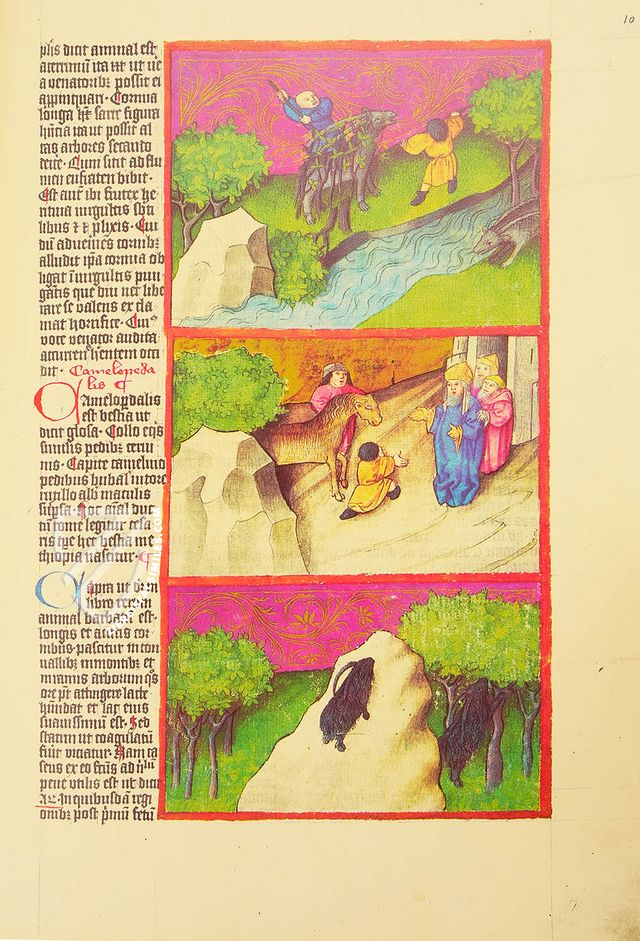
#1 Liber de natura rerum
Languages: English, Spanish
(1,000€ - 3,000€)
- Treatises / Secular Books
- Apocalypses / Beatus
- Astronomy / Astrology
- Bestiaries
- Bibles / Gospels
- Chronicles / History / Law
- Geography / Maps
- Saints' Lives
- Islam / Oriental
- Judaism / Hebrew
- Single Leaf Collections
- Leonardo da Vinci
- Literature / Poetry
- Liturgical Manuscripts
- Medicine / Botany / Alchemy
- Music
- Mythology / Prophecies
- Psalters
- Other Religious Books
- Games / Hunting
- Private Devotion Books
- Other Genres
- Afghanistan
- Armenia
- Austria
- Belgium
- Colombia
- Croatia
- Cyprus
- Czech Republic
- Denmark
- Egypt
- Ethiopia
- France
- Germany
- Greece
- Hungary
- India
- Iran
- Iraq
- Israel
- Italy
- Japan
- Lebanon
- Luxembourg
- Mexico
- Morocco
- Netherlands
- Palestine
- Peru
- Poland
- Portugal
- Russia
- Serbia
- Spain
- Sri Lanka
- Sweden
- Switzerland
- Syria
- Turkey
- Ukraine
- United Kingdom
- United States
- Uzbekistan
- Aboca Museum
- Ajuntament de Valencia
- Akademie Verlag
- Akademische Druck- u. Verlagsanstalt (ADEVA)
- Aldo Ausilio Editore - Bottega d’Erasmo
- Alecto Historical Editions
- Alkuin Verlag
- Almqvist & Wiksell
- Amilcare Pizzi
- Andreas & Andreas Verlagsbuchhandlung
- Archa 90
- Archiv Verlag
- Archivi Edizioni
- Arnold Verlag
- ARS
- Ars Magna
- ArtCodex
- AyN Ediciones
- Azimuth Editions
- Badenia Verlag
- Bärenreiter-Verlag
- Belser Verlag
- Belser Verlag / WK Wertkontor
- Benziger Verlag
- Bernardinum Wydawnictwo
- BiblioGemma
- Biblioteca Apostolica Vaticana (Vaticanstadt, Vaticanstadt)
- Bibliotheca Palatina Faksimile Verlag
- Bibliotheca Rara
- Boydell & Brewer
- Bramante Edizioni
- Bredius Genootschap
- Brepols Publishers
- British Library
- C. Weckesser
- Caixa Catalunya
- Canesi
- CAPSA, Ars Scriptoria
- Caratzas Brothers, Publishers
- Carus Verlag
- Casamassima Libri
- Chavane Verlag
- Christian Brandstätter Verlag
- Circulo Cientifico
- Club Bibliófilo Versol
- Club du Livre
- CM Editores
- Collegium Graphicum
- Collezione Apocrifa Da Vinci
- Comissão Nacional para as Comemorações dos Descobrimentos Portugueses
- Coron Verlag
- Corvina
- CTHS
- D. S. Brewer
- Damon
- De Agostini/UTET
- De Nederlandsche Boekhandel
- De Schutter
- Deuschle & Stemmle
- Deutscher Verlag für Kunstwissenschaft
- DIAMM
- Droz
- E. Schreiber Graphische Kunstanstalten
- Ediciones Boreal
- Ediciones Grial
- Ediclube
- Edições Inapa
- Edilan
- Editalia
- Edition Deuschle
- Edition Georg Popp
- Edition Leipzig
- Edition Libri Illustri
- Editiones Reales Sitios S. L.
- Éditions de l'Oiseau Lyre
- Editions Medicina Rara
- Editorial Casariego
- Editorial Mintzoa
- Editrice Antenore
- Editrice Velar
- Edizioni Edison
- Egeria, S.L.
- Eikon Editores
- Electa
- Emery Walker Limited
- Enciclopèdia Catalana
- Eos-Verlag
- Ephesus Publishing
- Ernst Battenberg
- Eugrammia Press
- Extraordinary Editions
- Fackelverlag
- Facsimila Art & Edition
- Facsimile Editions Ltd.
- Facsimilia Art & Edition Ebert KG
- Faksimile Verlag
- Feuermann Verlag
- Folger Shakespeare Library
- Franco Cosimo Panini Editore
- Friedrich Wittig Verlag
- Fundación Hullera Vasco-Leonesa
- G. Braziller
- Gabriele Mazzotta Editore
- Gebr. Mann Verlag
- Gesellschaft für graphische Industrie
- Getty Research Institute
- Giovanni Domenico de Rossi
- Giunti Editore
- Graffiti
- Grafica European Center of Fine Arts
- Guido Pressler
- Guillermo Blazquez
- Gustav Kiepenheuer
- H. N. Abrams
- Harrassowitz
- Helikon
- Hendrickson Publishers
- Henning Oppermann
- Herder Verlag
- Hes & De Graaf Publishers
- Hoepli
- Holbein-Verlag
- Hortus Deliciarum
- Houghton Library
- Hugo Schmidt Verlag
- Idion Verlag
- Il Bulino, edizioni d'arte
- ILte
- Imago
- Insel Verlag
- Instituto Nacional de Antropología e Historia
- Istituto dell'Enciclopedia Italiana - Treccani
- Istituto Ellenico di Studi Bizantini e Postbizantini
- Istituto Geografico De Agostini
- Istituto Poligrafico e Zecca dello Stato
- Italarte Art Establishments
- J. Thorbecke
- Jan Thorbecke Verlag
- Johnson Reprint Corporation
- Josef Stocker
- Josef Stocker-Schmid
- Jugoslavija
- Karl W. Hiersemann
- Kasper Straube
- Kaydeda Ediciones
- Kindler Verlag / Coron Verlag
- Kodansha International Ltd.
- Konrad Kölbl Verlag
- Kurt Wolff Verlag
- La Liberia dello Stato
- La Linea Editrice
- La Meta Editore
- Lambert Schneider
- Landeskreditbank Baden-Württemberg
- Leo S. Olschki
- Les Incunables
- Library of Congress
- Libreria Musicale Italiana
- Lichtdruck
- Lito Immagine Editore
- Lumen Artis
- Lund Humphries
- M. Moleiro Editor
- Maison des Sciences de l'homme et de la société de Poitiers
- Manuscriptum
- Martinus Nijhoff
- Maruzen-Yushodo Co. Ltd.
- MASA
- McGraw-Hill
- Militos
- Millennium Liber
- Müller & Schindler
- Nahar and Steimatzky
- National Library of Wales
- Neri Pozza
- Nova Charta
- Oceanum Verlag
- Odeon
- Orbis Mediaevalis
- Orbis Pictus
- Österreichische Staatsdruckerei
- Oxford University Press
- Pageant Books
- Parzellers Buchverlag
- Patrimonio Ediciones
- Pattloch Verlag
- PIAF
- Pieper Verlag
- Plon-Nourrit et cie
- Prestel Verlag
- Princeton University Press
- Prisma Verlag
- Priuli & Verlucca, editori
- Pro Sport Verlag
- Propyläen Verlag
- Pytheas Books
- Quaternio Verlag Luzern
- Reales Sitios
- Recht-Verlag
- Reichert Verlag
- Reichsdruckerei
- Riehn & Reusch
- Roberto Vattori Editore
- Rosenkilde and Bagger
- Roxburghe Club
- Salerno Editrice
- Sarajevo Svjetlost
- Schöck ArtPrint Kft.
- Scolar Press
- Scrinium
- Scripta Maneant
- Scriptorium
- Siloé, arte y bibliofilia
- SISMEL - Edizioni del Galluzzo
- Sociedad Mexicana de Antropología
- Société des Bibliophiles & Iconophiles de Belgique
- Soncin Publishing
- Sorli Ediciones
- Stainer and Bell
- Studer
- Styria Verlag
- Sumptibus Pragopress
- Szegedi Tudomànyegyetem
- Taberna Libraria
- Tarshish Books
- Taschen
- Tempus Libri
- Testimonio Compañía Editorial
- Thames and Hudson
- The Clear Vue Publishing Partnership Limited
- The Facsimile Codex
- The Folio Society
- The Marquess of Normanby
- The Richard III and Yorkist History Trust
- Tip.Le.Co
- TouchArt
- TREC Publishing House
- TRI Publishing Co.
- Trident Editore
- Typis Regiae Officinae Polygraphicae
- Union Verlag Berlin
- Universidad de Granada
- University of California Press
- University of Chicago Press
- Urs Graf
- Vallecchi
- Van Wijnen
- VCH, Acta Humaniora
- VDI Verlag
- VEB Deutscher Verlag für Musik
- Verlag Anton Pustet / Andreas Verlag
- Verlag Bibliophile Drucke Josef Stocker
- Verlag der Münchner Drucke
- Verlag für Regionalgeschichte
- Verlag Styria
- Vicent Garcia Editores
- W. Turnowsky
- Waanders Printers
- Wiener Mechitharisten-Congregation (Wien, Österreich)
- Wissenschaftliche Buchgesellschaft
- Wydawnictwo Dolnoslaskie
- Xuntanza Editorial
- Zakład Narodowy
- Zollikofer AG






